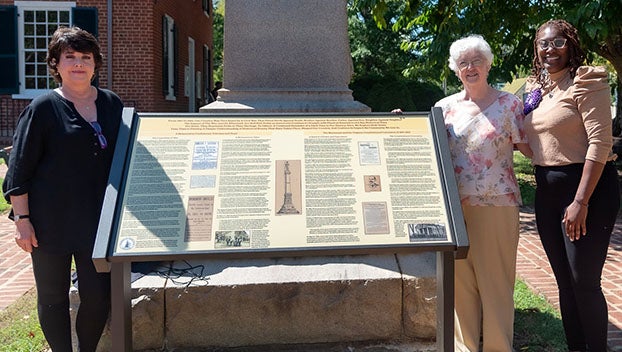Charlotte County shares historic context of Confederate monument
Published 9:00 am Wednesday, September 20, 2023

- Kathy Liston, left, a professional archaeologist and historian, Cora St. John, president of the Charlotte County APVA and a member of the United Daughters of the Confederacy, and Monique Williams, right, an educator and activist for social justice, spent a year carefully researching, writing, and designing the large panel sign that now stands at the base of the monument.
|
Getting your Trinity Audio player ready...
|
On a sunny September afternoon, in the shadow of the 200-year-old courthouse designed by Thomas Jefferson, Charlotte County once again made history, becoming the first place in Virginia to erect a sign explaining the historical context of its Confederate Monument.
The sign tells the story of how the monument came to be, paid for with monies raised by Confederate women and veterans and the local government, while also placing it in the context of post-Reconstruction Virginia and the erosion of hard-won Black civil rights.
The text is factual and objective, addressing both viewpoints of this divisive issue: the monument as a memorial to the dead and symbol of heritage, and the monument as a symbol of power and oppression.
Three local women: Monique Williams, an educator and activist for social justice, Cora St. John, president of the Charlotte County APVA and a member of the United Daughters of the Confederacy, and Kathy Liston, a professional archaeologist and historian, spent a year carefully researching, writing, and designing the large panel sign that now stands at the base of the monument.
The program began in the Historic Courthouse itself with Liston giving an overview of how the sign came to be. Stressing that this sign gave everyone the chance to learn about what was going on at the time the monument was erected, rather than just removing the problem without addressing the underlying issues.
She then introduced Gary Walker, chairman of the Board of Supervisors, who welcomed the crowd and praised the women for their hard work.
He was followed by the keynote speaker, Julie Langan, Director of the Department of Historic Resources and State Historic Preservation Officer. Langan talked about her own struggles with her personal feelings about these monuments vs. what she must present as the head of a government agency. She speculated on what might have happened to the statues in Richmond and other places if they had been contextualized instead of removed. She praised Charlotte County for having the courage to address the difficult issue of what to do with these monuments head on, and for coming up with a novel approach that treats both sides of the discussion fairly.
Monique Williams then spoke about what the monument represented to her as a Black woman, and how she became more understanding of other points of view while working on the sign.
Cora St. John explained how she was hesitant when first asked to join the group but then decided it was important that the heritage aspect of the monument be represented. She described how well they all worked together, with an atmosphere of genuine respect for the material and each other.
After some closing remarks, everyone went outside to unveil the sign, then enjoyed refreshments on the courthouse porch.



